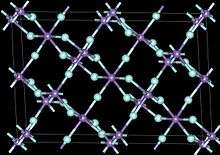Manganese(III) fluoride
Manganese(III) fluoride (also known as Manganese trifluoride) is the inorganic compound with the formula MnF3. This red/purplish solid is useful for converting hydrocarbons into fluorocarbons, i.e., it is a fluorination agent.[1] It forms a hydrate and many derivatives.
 | |
| Names | |
|---|---|
| IUPAC name
Manganese(III) fluoride | |
| Other names
Manganese trifluoride, manganic fluoride | |
| Identifiers | |
3D model (JSmol) |
|
| ChemSpider | |
| ECHA InfoCard | 100.029.096 |
PubChem CID |
|
| RTECS number |
|
| UNII | |
CompTox Dashboard (EPA) |
|
| |
| |
| Properties | |
| MnF3 | |
| Molar mass | 111.938 g/mol |
| Appearance | purple-pink powder hygroscopic |
| Density | 3.54 g/cm3 |
| Melting point | > 600 °C (1,112 °F; 873 K) (decomposes) |
| hydrolysis | |
| +10,500·10−6 cm3/mol | |
| Structure | |
| Monoclinic, mS48 | |
| C2/c, No. 15 | |
| distorted octahedral | |
| Hazards | |
| Main hazards | toxic fumes |
| R-phrases (outdated) | 8-20/21/22-36/37/38 |
| S-phrases (outdated) | 17-26-36/37/39 |
| Related compounds | |
Other anions |
manganese(III) oxide, manganese(III) acetate |
Other cations |
chromium(III) fluoride, iron(III) fluoride. cobalt(III) fluoride |
Related compounds |
manganese(II) fluoride, manganese(IV) fluoride |
Except where otherwise noted, data are given for materials in their standard state (at 25 °C [77 °F], 100 kPa). | |
| Infobox references | |
Synthesis, structure and reactions
MnF3 can be prepared by treating a solution of MnF2 in hydrogen fluoride with fluorine:[2]
- MnF2 + 0.5 F2 → MnF3
It can also be prepared by the reaction of elemental fluorine with a manganese(II) halide at ~250 °C.[3]
Structure
Like vanadium(III) fluoride, MnF3 features octahedral metal centers with the same average M-F bond distances. In the Mn compound, however, is distorted (and hence a monoclinic unit cell vs. a higher symmetry one) due to the Jahn-Teller effect, with pairs of Mn-F distances of 1.79, 1.91, 2.09 Å.[4][5][6]
The hydrate MnF3.3H2O is obtained by crystallisation of MnF3 from hydrofluoric acid. The hydrate exists as two polymorphs, with space groups P21/c and P21/a. Each consists of the salt [Mn(H2O)4F2]+[Mn(H2O)2F4]− ).[7]
Reactions
MnF3 is Lewis acidic and forms a variety of derivatives. One example is K2MnF3(SO4).[8] MnF3 reacts with sodium fluoride to give the octahedral hexafluoride:[3]
- 3NaF + MnF3 → Na3MnF6
Related reactions salts of the anions MnF52− or MnF4−. These anions adopt chain and layer structures respectively, with bridging fluoride. Manganese remains 6 coordinate, octahedral, and trivalent in all of these materials.[3]
Manganese(III) fluoride fluorinates organic compounds including aromatic hydrocarbons,[9] cyclobutenes,[10] and fullerenes.[11]
On heating, MnF3 decomposes to manganese(II) fluoride.[12][13]
See also
- CoF3, another fluorinating agent based on a transition metal in an oxidising +3 state.
References
- Burley, G. A.; Taylor, R. (2004). "Manganese(III) Fluoride". Encyclopedia of Reagents for Organic Synthesis. J. Wiley & Sons. doi:10.1002/047084289X.rn00411.
- Z. Mazej (2002). "Room temperature syntheses of MnF3, MnF4 and hexafluoromanganete(IV) salts of alkali cations". Journal of Fluorine Chemistry. 114 (1): 75–80. doi:10.1016/S0022-1139(01)00566-8.
- Inorganic chemistry, Catherine E. Housecroft, A.G. Sharpe, pp.711-712, section Manganese (III) , googlebooks link
- Wells, A.F. (1984) Structural Inorganic Chemistry, Oxford: Clarendon Press. ISBN 0-19-855370-6.
- Hepworth, M. A.; Jack, K. H.; Nyholm, R. S. (1957). "Interatomic Bonding in Manganese Trifluoride". Nature. 179 (4552): 211–212. Bibcode:1957Natur.179..211H. doi:10.1038/179211b0.
- M. A. Hepworth; K. H. Jack (1957). "The Crystal Structure of Manganese Trifluoride, MnF3". Acta Crystallographica. 10 (5): 345–351. doi:10.1107/S0365110X57001024.
- Molinier Michel; Massa Werner (1992). "Structures of two polymorphs of MnF3·3H2O". Journal of Fluorine Chemistry. 57 (1–3): 139–146. doi:10.1016/S0022-1139(00)82825-0.
- Bhattacharjee, M. N; Chaudhuri, M. K. (1990). Dipotassium Trifluorosulfatomanganate(III). Inorg. Synth. Inorganic Syntheses. 27. pp. 312–313. doi:10.1002/9780470132586.ch61. ISBN 9780470132586.
- Fluorination of p-chlorobenzotrifluoride by manganese trifluoride Archived 2011-08-23 at the Wayback Machine A. Kachanov, V. Kornilov, V.Belogay , Fluorine Notes :Vol. 1 (1) November–December 1998 , via notes.fluorine1.ru
- Junji Mizukado, Yasuhisa Matsukawa, Heng-dao Quan, Masanori Tamura, Akira Sekiya (2006). "Fluorination of Fluoro-Cyclobutene with High-Valency Metal Fluoride". Journal of Fluorine Chemistry. 127: 79–84. doi:10.1016/j.jfluchem.2005.10.007.CS1 maint: uses authors parameter (link)
- V. É. Aleshina, A. Ya. Borshchevskii, E. V. Skokan, I. V. Arkhangel’skii, A.V. Astakhov, N.B. Shustova (2002). "Fluorination of the Cubic and Hexagonal C60 Modifications by Crystalline Manganese Trifluoride". Physics of the Solid State. 44 (4): 629–630. Bibcode:2002PhSS...44..629A. doi:10.1134/1.1470543.CS1 maint: uses authors parameter (link)
- Chisholm, Hugh, ed. (1911). . Encyclopædia Britannica. 17 (11th ed.). Cambridge University Press. p. 570.
- In situ time-resolved X-ray diffraction study of manganese trifluoride thermal decomposition , J.V. Raua, V. Rossi Albertinib, N.S. Chilingarova, S. Colonnab, U. Anselmi Tamburini, Journal of Fluorine Chemistry 4506 (2001) 1–4 , online version
Further reading
- Novel syntheses of some binary fluorides: the role of anhydrous hydrogen fluoride Acta Chim. Slov. 1999, 46(2), pp. 229–238, Zoran Mazej, Karel Lutar and Boris Žemva
- Knudsen Cell mass spectrometry study of Manganese Trifluoride vaporisation, High temperature corrosion and materials chemistry IV: proceedings of the International Symposium, pp. 521–525, google books
External links
- National Pollutant Inventory: Fluoride and compounds fact sheet
- National Pollutant Inventory: Manganese and compounds Fact Sheet